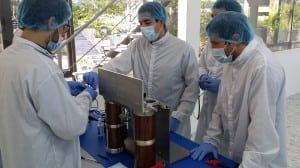Latest News

Satellogic’s new satellite production facility that opened in Montevideo in July 2015. Photo: Satellogic
[Via Satellite 03-17-2016] Small satellite startup Satellogic is on its way to building and orbiting a constellation of 300 Earth Observation (EO) satellites to provide near-real time imagery of the Earth, with the first non-prototype launches slated to occur this year. Having already launched three prototype satellites between 2013 and 2014, Satellogic opened a manufacturing facility in Montevideo, Uruguay last year with the potential to build several dozen satellites per year — something the company feels is necessary to support a constellation of this size.
Emiliano Kargieman, founder and CEO of Satellogic, told Via Satellite that the factory has a 10,000 square foot clean room, able to produce the SmallSats in large quantities. Satellogic chose the location because of its close proximity to the company’s largest Research and Development (R&D) facility in Buenos Aires, Argentina. Each spacecraft in the constellation is to have an approximate weight of 35 kilograms, and will perform one-meter multispectral imaging. With multiple pilot programs already underway with prospective customers, Satellogic is eager to get its fleet in orbit. Kargieman said the factory will be dedicated exclusively to producing the company’s own spacecraft
“The factory is dimensioned to allow us to build in excess of 50 of our satellites per year, so we expect to keep it busy over the next few years as we grow our constellation,” he said.
Satellogic originally planned to begin launching its satellites in 2015, so that a service constellation of 16 spacecraft would be active this year, but launch delays have stretched out this timeline. Kargieman said the company now plans to have an initial constellation of six satellites by year’s end, with two launching May 30 on a Long March 4B from China, and another four later on aboard a Russian Dnepr rocket.
“It’s a tough market for launch. The one we are doing in May was originally scheduled for December 2015. In a similar way Dnepr launches for their own political reasons were delayed,” explained Kargieman. “We still expect to complete the constellation of 16 satellites. It will be later than we originally planned; it will be in the first two quarters of 2017.”
SmallSats, due to their lower commercial launching value, are frequently relegated to the role of secondary payloads, paying deference to larger spacecraft that dictate missions. Kargieman said Satellogic is pursuing launch opportunities for another 19 SmallSats in 2017, after the original six, in hopes that launch will not continue to be an obstacle.
“Other opportunities to launch satellites that we are considering would potentially put us in a position to grow our constellation further than that up to 25 satellites during the year. Of course, that all is pending on launches going according to plan. If we have to judge by previous history, then it’s reasonable to expect a few delays,” he said.
In the wake of the recent SmallSat boom, a groundswell of new launch companies offering dedicated services tailored for this market has emerged. Kargieman said Satellogic is closely following these new entrants. Among the new players, Rocket Lab’s Electron launch vehicle and Virgin Galactic’s LauncherOne rocket are currently scheduled for maiden flights in 2017. Both won CubeSat launch contracts from NASA last year along with Firefly Space Systems, whose Firefly Alpha vehicle is scheduled for suborbital flight in 2017, followed by orbital missions in 2018. Kargieman expressed interest in new players offering these types of services, and said Satellogic is “talking to all of them.”
“We really hope to see more availability in launch; particularly not only more availability, but faster turnarounds and shorter cycles to get our satellites in orbit,” he said. “We are also expecting — and this is the part where the promise still needs to pay off — that this will translate into more reasonable costs for launching into orbit. So far, from the small launchers, we have seen really good value propositions in terms of responsiveness, but not necessarily very competitive pricing. We expect the competition will drive prices down to bring not only more responsive, but also more competitive launch opportunities in the next few years.”
Kargieman said it will take several years to complete the constellation of 300 SmallSats, but that this is the requisite number for Satellogic to achieve the imaging rate it desires.
“A constellation of 300 satellites would allow us to average revisit times of around 5 minutes anywhere on the planet for one meter resolution multi-spectral imaging,” he said.
The first constellation would have a revisit rate starting around 2 hours for anywhere on Earth, he said.
Regarding other constellation prep, Kargieman said Satellogic is building a network of ground stations to support the large stream of data its satellites intend to produce. He said the company will use a combination of its own ground stations and third party stations to tap into a network of more than 20 around the world. Satellogic has two of its own stations operational today, and plans to complete another two before the end of the year. Kargieman said the company is also working on downstream analytics platforms for customers to access data without having to develop their own cumbersome image processing capabilities.
Satellogic has pilot programs with end users in the energy and agriculture markets today. Kargieman said the energy studies have focused on pipeline monitoring for oil and gas, and agriculture studies on crop monitoring oriented toward precision agriculture. The company is also examining opportunities in forestry related to calculating and maintaining wood stocks, and looking at carbon capture.
Get the latest Via Satellite news!
Subscribe Now